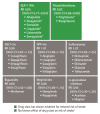Diabetes and Stroke: What Are the Connections?
- PMID: 36592968
- PMCID: PMC9911852
- DOI: 10.5853/jos.2022.02306
Diabetes and Stroke: What Are the Connections?
Abstract
Stroke is a major cause of death and long-term disability worldwide. Diabetes is associated with an increased risk of cardiovascular complications, including stroke. People with diabetes have a 1.5-2 times higher risk of stroke compared with people without diabetes, with risk increasing with diabetes duration. These risks may also differ according to sex, with a greater risk observed among women versus men. Several mechanisms associated with diabetes lead to stroke, including large artery atherosclerosis, cerebral small vessel disease, and cardiac embolism. Hyperglycemia confers increased risk for worse outcomes in people presenting with acute ischemic stroke, compared with people with normal glycemia. Moreover, people with diabetes may have poorer post-stroke outcomes and higher risk of stroke recurrence than those without diabetes. Appropriate management of diabetes and other vascular risk factors may improve stroke outcomes and reduce the risk for recurrent stroke. Secondary stroke prevention guidelines recommend screening for diabetes following a stroke. The diabetes medications pioglitazone and glucagon-like peptide-1 receptor agonists have demonstrated protection against stroke in randomized controlled trials; this protective effect is believed to be independent of glycemic control. Neurologists are often involved in the management of modifiable risk factors for stroke (including hypertension, hyperlipidemia, and atrial fibrillation), but less often in the direct management of diabetes. This review provides an overview of the relationships between diabetes and stroke, including epidemiology, pathophysiology, post-stroke outcomes, and treatments for people with stroke and diabetes. This should aid neurologists in diabetes-related decision-making when treating people with acute or recurrent stroke.
Keywords: Diabetes mellitus; Hyperglycemia; Outcome assessment; Risk; Stroke.
Figures



References
-
- O’Donnell MJ, Xavier D, Liu L, Zhang H, Chin SL, Rao-Melacini P, et al. Risk factors for ischaemic and intracerebral haemorrhagic stroke in 22 countries (the INTERSTROKE study): a case-control study. Lancet. 2010;376:112–123. - PubMed
-
- International Diabetes Federation . Brussels: International Diabetes Federation; 2021. IDF Diabetes Atlas. Diabetes around the world in 2021 [Internet] [cited 2021 Nov 12]. Available from: https://diabetesatlas.org.
-
- Visseren FLJ, Mach F, Smulders YM, Carballo D, Koskinas KC, Bäck M, et al. 2021 ESC guidelines on cardiovascular disease prevention in clinical practice. Eur Heart J. 2021;42:3227–3337. - PubMed
Publication types
Grants and funding
LinkOut - more resources
Full Text Sources

